
Birding Around Las Vegas, Lake Mead Area

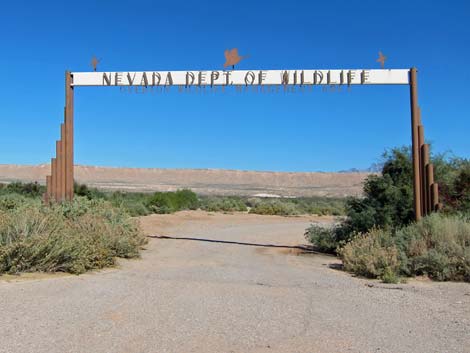 Nevada Dept. of Wildlife, Overton Wildlife Mgmt. Area entrance sign |
Description Overton Wildlife Management Area (WMA) is located in the historic Lake Mead delta region where the Muddy River once flowed into the lake. Now the river supplies water to the WMA, but still waters of Lake Mead waters lie far to the south. The WMA has extensive, seasonally flooded marshes, saltcedar and willow thickets, honey mesquite and screwbean mesquite thickets, a few big cottonwood trees, grassy fields, and several ponds with different water depths. Much of the time spent birding here will involve slinking quietly along pond edges or trying to get little birds, hiding in the dense shrub thickets, to show themselves. Link to Entrance Area Map or WMA map. |
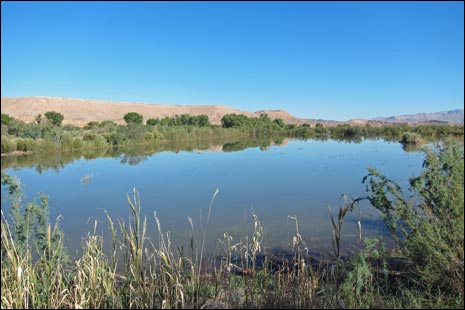 |
The WMA is closed to birding on duck hunting days, otherwise it is always open, but not always open to vehicles (see Hours, below). It probably is worth a call to the WMA to check on flooding, hunting, and driving conditions before heading out to Overton. Once there, be careful driving on the dirt roads: if a road looks wet, get out and walk it to see if it is safe to continue driving. The soils are sandy silt, and they get surprisingly soft and sticky when wet: better to have muddy shoes than a vehicle stuck in the mud. There is a free campground along the WMA entrance road, so birders can get a late start from Las Vegas, camp outside the gate, and hike into the WMA before dawn to do some early-morning birding. Bring your own water. An outhouse is located past check station, inside the gate, 60 yards down the road to the right (about 300 yards from the last campsite). |
 |
Location Overton WMA is located about 1.25 hours northeast of Las Vegas. The easiest way to get there from town is to drive north on Interstate-15 to the Logandale exit (Exit 93). Turn right onto Highway 169 and drive south through the towns of Logandale and Overton where gas, food, and other supplies are available. About 1.5 miles south of the Lost City Museum (south end of Overton), turn left onto Waterfowl Road (Table 1, Site 0447) and pass under the Overton Wildlife Management Area entrance sign. Follow the dirt road to the right (south) for about 0.3 miles to the parking area by the check station (Site 0665). If the white gate next to the check station is closed, blocking the bridge over a canal, park in the big, dirt parking area on the right. Bird the mesquite thickets around the parking area, then walk around the gate, over the canal, and into the WMA. |
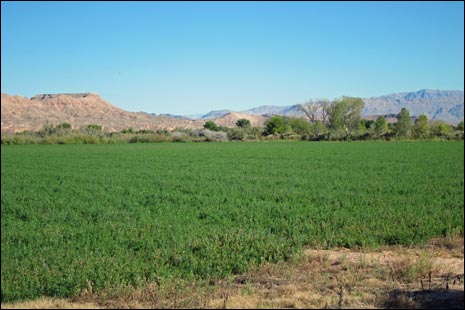 Growing crops for duck food |
If the gate is open and it is the right time of year (see Hours, below), drive across the canal (be sure to stop at the check station if anyone is there). Across the canal, dirt roads diverge and lead into the WMA. A nice 2-mile loop (or shorter versions) can be driven or walked on the road that starts just past the check station outhouse (from the gate, to the right 85 yards) and leads eastward to grassy fields, canals, ponds, and thickets. The road southward from the outhouse leads to thickets and a large pond. Hours Birders can walk into the WMA at any time of day or night during the non-hunting season and on non-waterfowl-hunting days. Birders can drive into the area when WMA personnel are on duty, except not during the general hunting season. On hunt days, the WMA is closed to everyone except permitted hunters. Access to the WMA is a bit confusing and differs, with good reason, during the hunting and non-hunting seasons: |
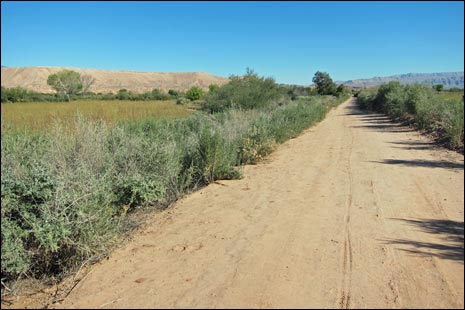 |
Some exceptions apply, so it probably is worth a call to the WMA to check on flooding, hunting, and driving conditions before driving out to Overton. |
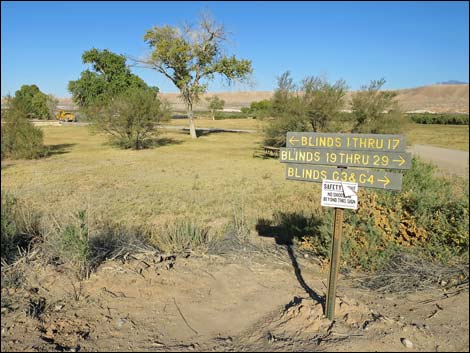 |
Waterfowl hunting is permitted on the Moapa Valley portion of Overton WMA on (from 2025 NDOW regulations): a) the opening day of waterfowl season, b) even days thereafter through the end of waterfowl season, c) the final two days of the waterfowl season, and d) during any youth waterfowl hunt. ... and therefore, the area is closed to birders these days.
Entry Fees: None. |
 |
Specialties This is the easiest place in Southern Nevada to see Wild Turkeys, and it is a great place to see waterfowl and wading birds in season. Birding is good on the WMA. Look for waterbirds (e.g., American Coot, Bufflehead, Ruddy Duck, Gadwall, Mallard, Northern Pintail, Redhead, Northern Shoveler, Canada Goose, Tundra Swan, and Eared Grebe, plus gulls and terns); hawks and similar species (e.g., Northern Harrier, Red-tailed Hawk, American Kestrel, Turkey Vulture, Bald Eagle), Sandhill Cranes; resident and migrant passerines (e.g., Brewer's Blackbird and Red-winged Blackbird; Gray Flycatcher; Western Kingbird; Say's Phoebe and Black Phoebe; Black-tailed Gnatcatcher and Blue-gray Gnatcatcher; Lesser Goldfinch; Western Meadowlark; Woodhouse's Scrub-Jay; Townsend's Solitaire; Northern Rough-winged Swallow and Tree Swallow; Brewer's Sparrow, Song Sparrow, and White-crowned Sparrow; Abert's Towhee; Yellow-rumped Warbler; and Marsh Wren). |
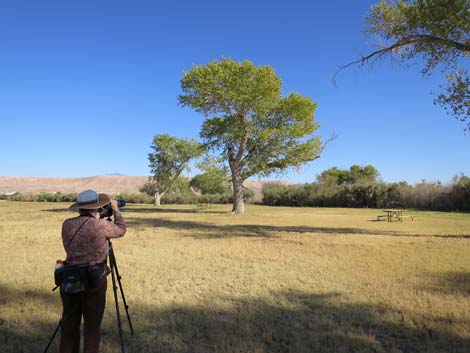 Birder with spotting scope |
Also look for migrant shorebirds (e.g., American Avocet, Short-billed Dowitcher, and Least Sandpiper), and wading birds (e.g., Great Egret, Snowy Egret, and Great Blue Heron). In the upland areas, such as around the hunter check station, look for Black-tailed Gnatcatcher, Phainopepla, Northern Mockingbirds, Gambel's Quail, Mourning Doves, House Finches, Rock Pigeon, and migrant sparrows. Odd species show up too. Always keep half an eye out for Trumpeter Swan (Jan 2013), Common Crane (Jan 2013), Yuma Clapper Rail, Thick-billed Kingbird (Nov 2014), and Ruddy Ground-Dove (Nov 2014). Keep an eye out for dragonflies too. For More Information Call the WMA at (702) 397-2142 or write to the Wildlife Area Supervisor; Overton Wildlife Management Area; P.O. Box 400; Overton, NV 89040. |
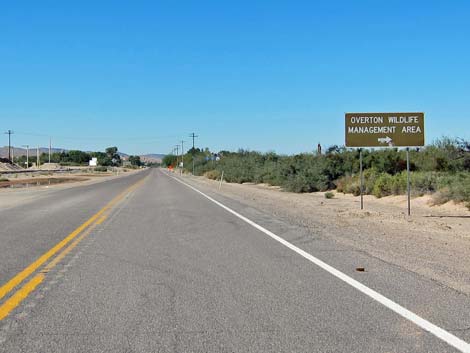 Entrance sign along Highway 169 (northbound from Lake Mead) |
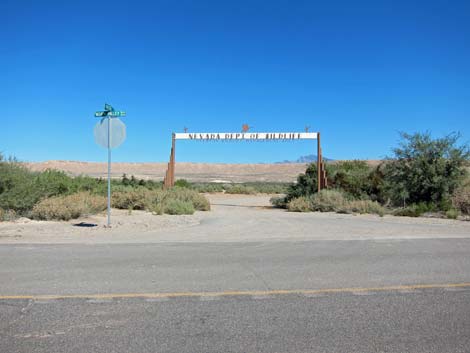 Entrance gate along Highway 169 (view E) |
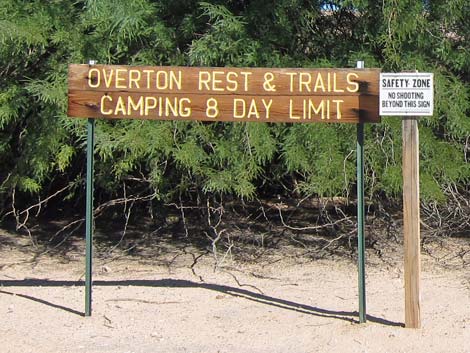 Campground sign (view E) |
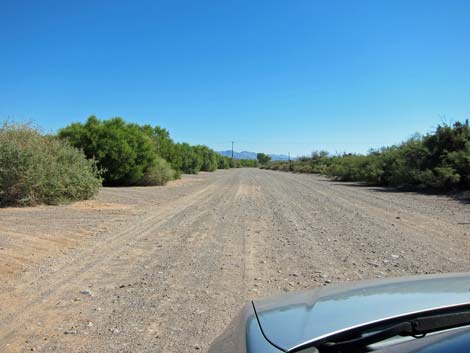 Entrance Road with campsites on the left (view S) |
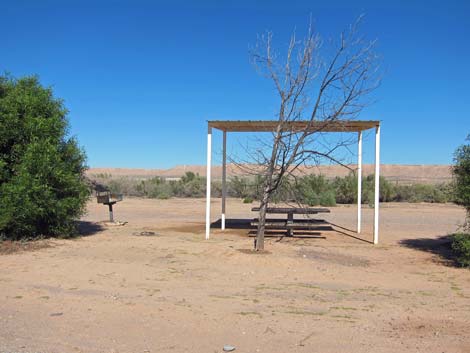 Campsite (view E) |
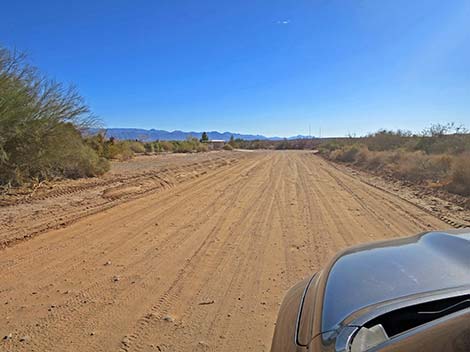 End of the entrance road (view S) |
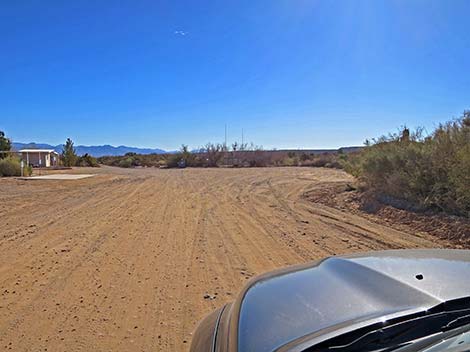 Approaching the Entrance Station (view S) |
 Approaching the Entrance Station; park on the right (view S) |
 Public parking is one the right, opposite the entrance station (view S) |
 A big, old cottonwood in the parking area has died, but ... |
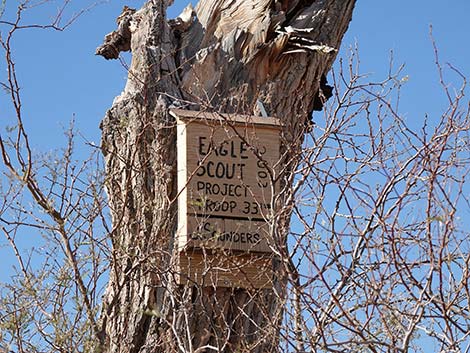 ... at least it still serves as a place to hang a bat roost box! |
 Entrance Station (view E from parking area) |
 Information sign in the parking area (view S) |
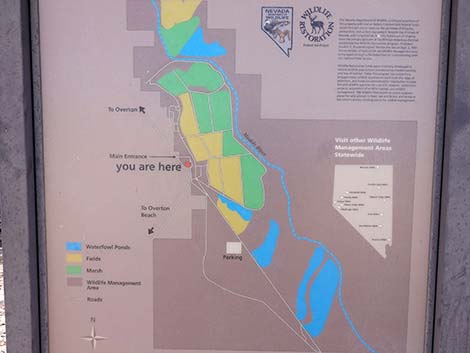 Map on the information sign |
 Entrance Station (view E) |
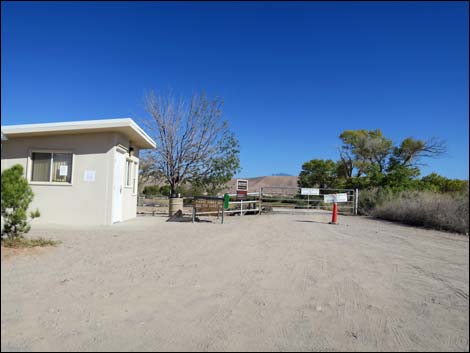 Entrance Station |
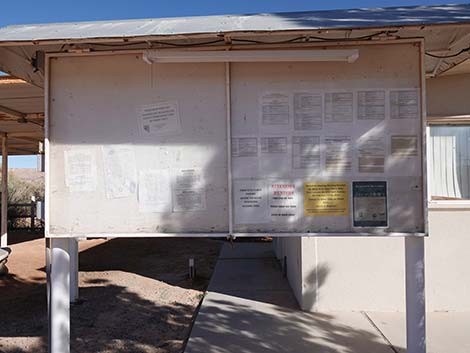 Information sign at Entrance Station (view E) |
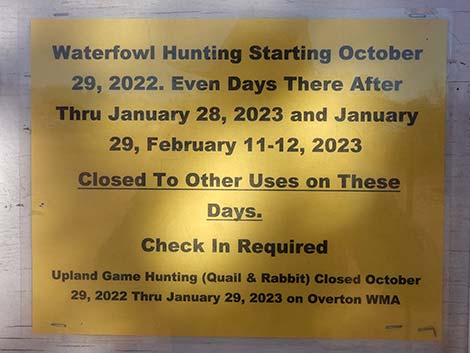 Only hunters in the WMA on hunt days |
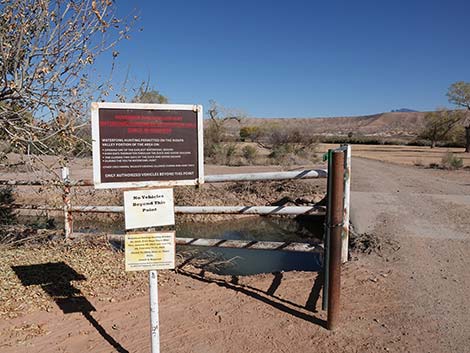 Sign at entrance gate (no vehicles past here during hunts) |
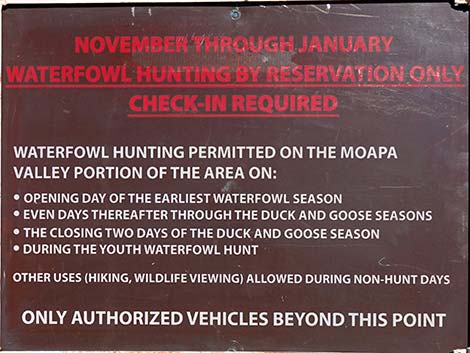 Sign at entrance gate (no vehicles past here during hunts) |
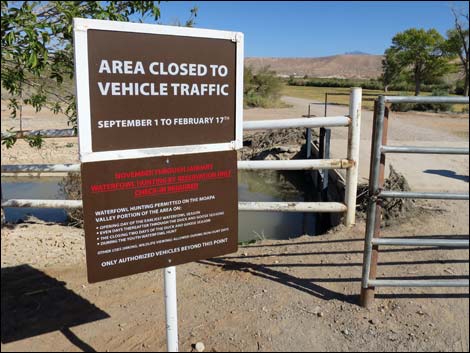 New sign is somewhat confusing; this old sign is more clear |
 Inside the gate, the Maintenance area is visible to the left (view NE) |
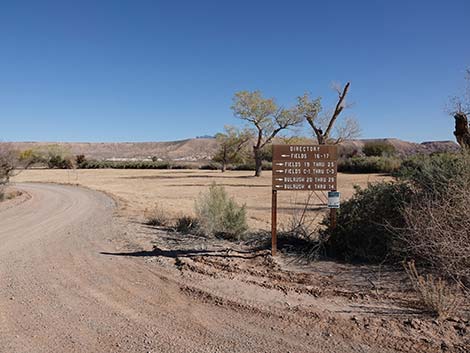 Directional signs point to duck blinds |
 Typical directional signs to duck blinds |
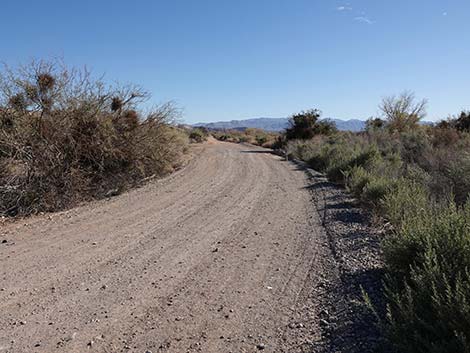 Inside the gate, road to the right (view S) |
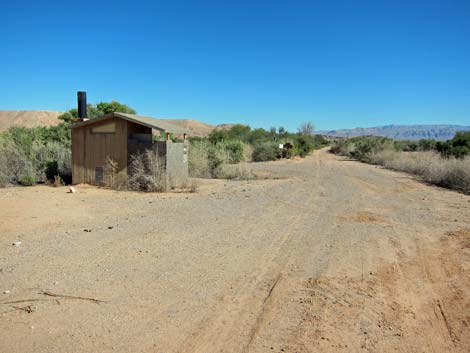 Toilets shortly inside gate on road to the right (view S) |
 Cottonwood tree with a bird on top |
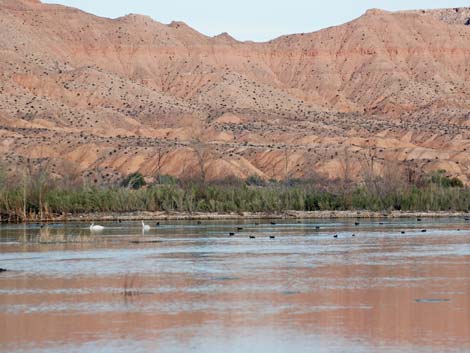 Evening glow on the hills |
 Wild Turkey in a new field |
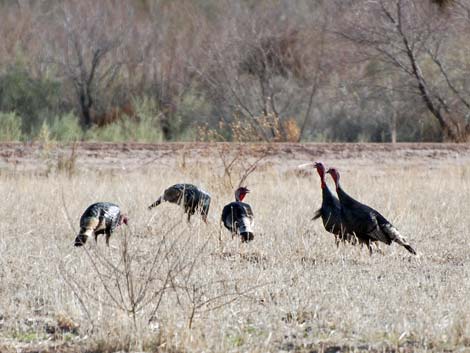 Wild Turkey in old field |
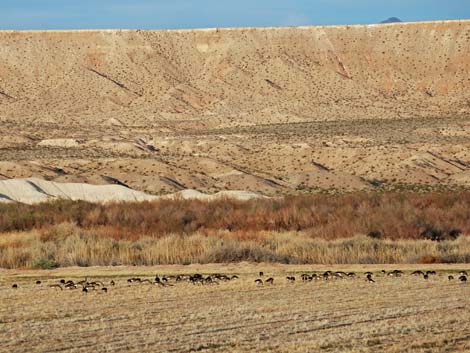 Canada Geese working the stubble |
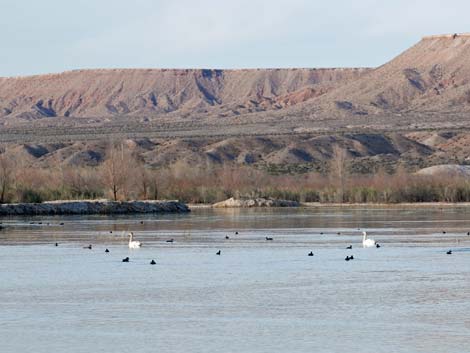 Swans and ducks |
 |
 |
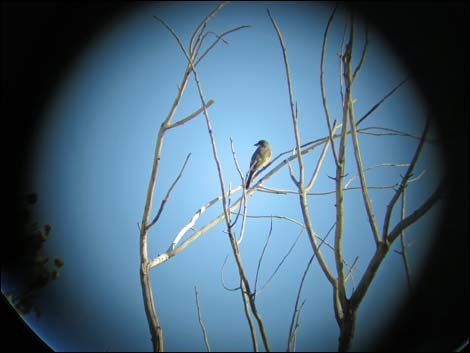 Thick-billed Kingbird |
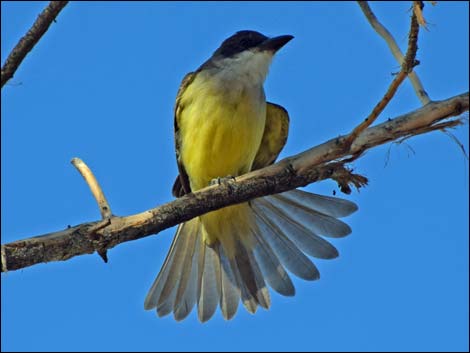 Thick-billed Kingbird (November 2014) |
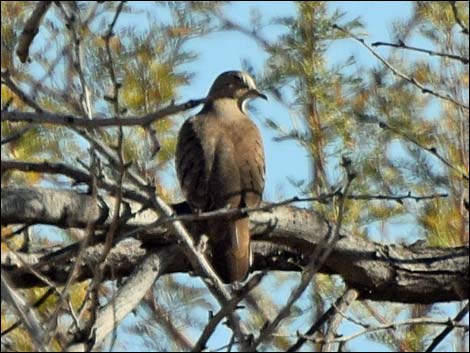 Ruddy Ground-Dove (November 2014) |
 Birder exiting the area |
Table 1. GPS Coordinates for Highway Locations (NAD27; UTM Zone 11S). Download Highway GPS Waypoints (*.gpx) file.
| Site # | Location | Latitude (°N) | Longitude (°W) | UTM Easting | UTM Northing | Elevation (feet) | Verified |
|---|---|---|---|---|---|---|---|
| 0447 | Overton WMA entrance | 36.5165 | 114.4241 | 730666 | 4044118 | 1,227 | Yes |
| 0665 | Overton WMA, Hunter Check Station | 36.5133 | 114.4213 | 730925 | 4043778 | 1,227 | Yes |
| 0666 | Overton WMA staff housing | 36.5216 | 114.4245 | 730612 | 4044684 | 1,237 | Yes |
Happy birding! All distances, elevations, and other facts are approximate.
![]() ; Last updated 241209
; Last updated 241209
| Birding Around Las Vegas | Southern Nevada Birds | Guide Service | Copyright, Conditions, Disclaimer | Home |